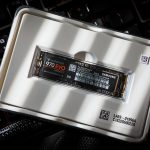For some time now, Samsung has used a marketing approach with respect to flash media that accommodates both business and the consumer. They produce the Pro M.2 NVMe SSD series for business and media needs and the EVO M.2 NVMe family for consumer use, and at a relatively modest price point. One has top performance and the other…is a bit …
Read More »Tag Archives: Vantage
Intel Optane Memory Review – 1.4GB/s Speed & 300K IOPS for $44
Intel Optane Memory is Intel’ first phase in release of their Optane flash technology line that Intel hopes might revolutionize the flash industry. At its most basic level, it is SSD storage that caches your hard drive with performance speeds up to 1.4GB/s, a speed that has yet to be seen for this type of storage in the industry. The term ‘Optane’ is …
Read More »WD Blue SSD Review (1TB) – WD Steps Into The Ring
Many of us know Western Digital as one of the largest HDD manufacturers in the market and that they have, for the most part, solely relied on HDD storage sales to become the giant they are today. In recent times they’ve adopted flash into their products. This resulted in the current WD Blue SSHD and back in 2014 the WD Black2 drive, which we saw …
Read More »Crucial MX300 SSD Review (1050GB) – Micron 3D NAND Meets RAID 0
Whether it be on cars or computers, enthusiasts are always looking for ways to improve performance, ways to just one up their friends, or even just ways to spend money on their hobby when they have nothing else to do with it. Who doesn’t like having the best of the best at times? We know we sure love it. But, …
Read More »Crucial MX300 SSD Review (750GB)
For what seemed like an eternity Samsung has been the leader in manufacturing 3D NAND. Starting with the release of the Samsung 850 Pro two years ago, they have paved the way for innovation. 3D NAND brings greater capacity, power efficiency, and lower cost to the consumers. After first announcing their 32-Layer 3D NAND last year in March, we have been …
Read More »SanDisk X400 SSD Review (512GB)
Targeted towards read-intensive workloads, boot, and logging applications in both servers and mobile computing, the X400 is SanDisk’s top-tier client SATA SSD available in both M.2 and 2.5″ form factors. Based on the marketing material it seems that SanDisk has put a lot of value into this drive, not only with its feature set, but performance and efficiency. The X400 is the …
Read More »Samsung 850 EVO SSD With 3rd Gen 48 Layer V-NAND Performance Comparison
Out with the old, in with the new is how the saying goes! Although, in this case, the old really isn’t that old and is still quite bleeding edge technology. This doesn’t stop Samsung though. Today we are going to take a look at the performance of Samsung’s 3rd generation 48-layer 256Gb TLC V-NAND. That is right, Samsung has now …
Read More »MyDigitalSSD BP4e mSATA SSD Review (512 GB) – Value Driven mSATA SSD & Gorgeous mSATA Enclosure
When we think of solid state drives today, two things comes to mind: how fast can it go and how much is going to cost me. Typically these two go hand in hand, the more speed you want the more it’s going to cost you. But what happens when you don’t want to fork out the big bucks for a …
Read More »Angelbird SSD wrk SSD Review (512GB) – Workmanship, Speed and Value
Being niche in a dog eat dog tech market can be very risky. Being niche in the SSD industry is straight up crazy as NAND manufacturers price their SSDs so low that 3rd party SSD manufacturers find it very hard to compete; or they shut down. More than a few companies have slowed, or shut down their SSD production and, …
Read More »Samsung 850 Pro SSD Review – Showing Off With 3D V-NAND
Some time ago, Samsung introduced their 3D V-NAND (vertical NAND) to the world and NAND flash memory took on a whole new look with what some might call, very high aspirations. Samsung was quick to point out that, as demands for reduced memory sizes increased, achieving a smaller footprint meant increased error rates and performance limitations. An example of this …
Read More » The SSD Review The Worlds Dedicated SSD Education and Review Resource |
The SSD Review The Worlds Dedicated SSD Education and Review Resource | 

